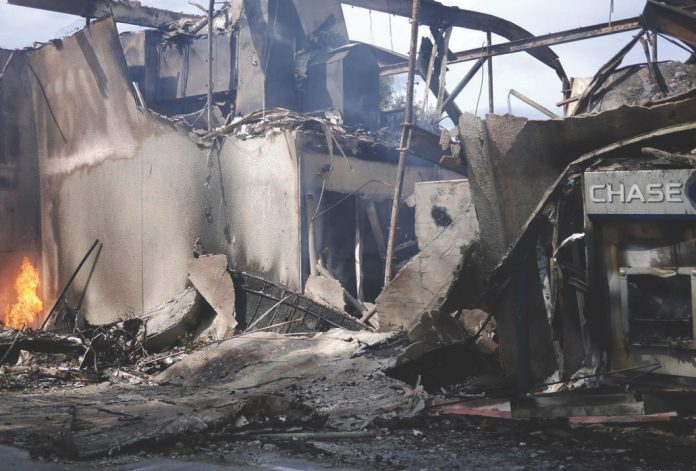
Security Risk Management firm Hillard Heintze presented their After Action report on the May 2019 Black Lives Matter-associated event to La Mesa City council members on Jan 26, nearly eight months after a planned peaceful protest escalated into a nighttime riot which left several historic buildings burned to the ground.
Organized after La Mesa Police Officer Matthew Dages arrested Amaurie Johnson for allegedly smoking near the Grossmont Trolley station, the destructive local event mirrored nationwide protests surrounding the murder of George Floyd, a Black man who died at the hands of a white police officer in Minneapolis.
Johnson is Black.
The After Action report Hillard Heintze representatives Robert Boehmer and Chad McGinty brought to the council presented an opportunity for elected officials to respond in a collective setting and unpack how to transform hindsight into policy.
According to Boehmer, six experts assembled the report for La Mesa based on documents from that evening; destroyed property sites; media recordings from dispatchers, video of the evening and interviews with police and fire department members as well as city council members; feedback from La Mesa Village businesses owners; a community listening session; varied responses from partner law enforcement agencies who were also on site at the May event.
From the beginning, McGinty said, La Mesa failed to plan ahead and execute a clear incident command plan.
“You need to quickly establish a centralized command. We also noted that the incident command post was established within the police station when information suggested that location was the target or focus of threat by the protest group,” McGinty said.
Operational plans needed more detail, McGinty said.
Minimal crowd control training came back to haunt the local police department as other agencies were deployed to La Mesa without a clear sense of which agency was serving as lead.
For example, when Heartland Fire was deployed, they found themselves operating in a hostile environment, McGinty said, which prevented them from staying on scene long enough to completely extinguish fires.
“In this particular instance, fire commanders had to make difficult decisions to enter into areas where they did not have police escorts and sent firefighters into areas where they were being pelted by rocks with hundreds of people converging on these scenes yet some of the firefighters stayed to do their job until law enforcement told them they had to leave,” McGinty said.
There were not enough supervisors on hand to build a command structure and lines of communication predictably broke down without a clear chain of command, further complicated by technical problems.
“Lack of formalized intelligence gathering and reporting was a challenge… Repeatedly, we heard there was a lack of communication, including with city officials. Another problem we found was a lack of radio interoperability. Some of the officers could not connect across jurisdictions,” McGinty said.
Finally, McGinty reported, “we found that La Mesa did not have robust written policies and strategies directly related to their community policing”.
The community, he said, has previously and repeatedly asked to have police officers trained in de-escalation techniques, to receive cultural diversity training, to analyze and release documented data from traffic stops, and to alter policies for mental health calls.
Moving forward, McGinty suggested the agency should establish a ‘First Amendment Rights’ policy and establish clear criteria and guidance for the development of operations plans based on that policy.
Additionally, he advised the agency to explore crowd control tactics, work with other agencies to develop a formal radio communications plan, and plan for regular after-action review. He also suggested county-wide emergency response training would benefit multiple agencies.
Following the presentation, city council members discussed the report and issued questions to Hillard Heintze representatives on key takeaways.
Council member Bill Baber tried to rebuild the chain of command miscommunications that ultimately led to violence and looting.
Interim La Mesa Chief of Police Captain Matt Nicholass said their initial approach was to remain inside the station and give people the ability to freely speak without police intrusion.
“As the crowd came closer and closer to the plaza, once someone destroyed the flag and prepared to light it on fire, we decided that was when we’d intervene and bring out resources,” Nicholass said.
Although Nicholass provided information from his perspective at the city council meeting, McGinty said they were challenged by receiving a “limited response” from all but one partner agency when they constructed the larger After Action report.
McGinty said the San Diego County Sheriff, for example, was responsive but did not provide expansive answers nor respond to three approaches for an interview.
San Diego Sheriff Commander Theresa Adams-Hydar later said her department “responded to their written format questions with written answers that would have been the same in a verbal one-on-one” and doesn’t recall being asked for an interview.
“I spoke directly to La Mesa’s Captain Nicholass… We were candid in our responses, they’re pretty cut and dried questions,” Adams-Hydar said.
Vice Mayor Akilah Weber questioned why nine months have passed since the event with city officials only now taking the time for a debrief.
“I think it is very important that after an incident we talk about it afterward, immediately because you remember at that time,” she said.
Weber also said she was disappointed to hear La Mesa’s Use of Force policy and Community Policing standards were out of date.
“This is something I addressed previously and was told it was going to happen after the incident at Helix High school,” Weber said, referring to a 2018 lawsuit in which a high school student sued a La Mesa police officer for use of excessive force.
Council member Jack Shu also said the after action report could have looked back and examined events at Helix High school, as well as the trolley incident that triggered the protest in the first place.
He also suggested the report is limited not just by isolating events but also by which voices it leaves out.
“This is a great report through the lenses of law enforcement; they are experts and I welcome that but it is very limited. What would this report look like if we went to the fire department or peacekeepers, community organizations, the faith community? What would that look like? I want to keep this in mind: this is a police report,” Shu said.
Community relations have to be part of community policing, he said.
“We do ‘coffee with a cop’ but until coffee includes Amari Johnson, until we go to the recent immigrants, people of color, low-income people, that isn’t the kind of coffee with a cop that is going to be effective,” Shu said.
La Mesa Mayor Mark Arapostathis said the protest was unprecedented but clearly showed the need for better communication, including having one dedicated Public Information Officer assigned to an event who “needs to use all things necessary including media to get information out” so the public and city officials know what is happening in their community.
“It’s important to realize when we get a report like this it isn’t the end, it’s the beginning,” Arapostathis said.













